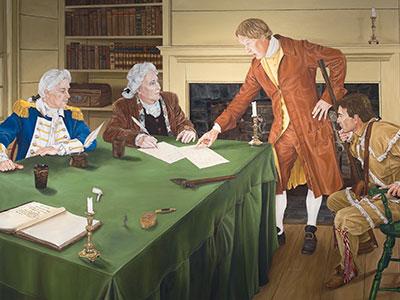
In 1792, the federal government’s western lands that eventually became Tennessee, especially the area around and beyond Knoxville, sat on the far edge of the frontier. Commonly called the “Southwest Territory,” these western federal lands consisted of two separate settlements—the Metro District, along the Cumberland River centered around what is now the Nashville area, and the Washington District, centered along the Holston River in what is now upper East Tennessee—both of which were separated from the rest of North Carolina by the Appalachian Mountains and from each other by a wide stretch of Indigenous Peoples' lands.
The site of Knoxville–and its designation as the capital of the Southwest Territory–had been settled on since Territorial Governor William Blount held a series of meetings near James White’s fort to create the Treaty of the Holston during May–July 1791. That the territory's new capital should also unite the area around it by becoming the seat of a new county was understood from the time James White’s son-in-law Charles McClung began laying out the town. With Knoxville’s future as capital and a county seat in mind, eight lots of the original 64 were set aside for municipal purposes, such as courthouses, a jail, military barracks, a school of higher education, and other institutions needed for the business of conducting federal, county, and local government. However, as the work of hewing out a town from an “ancient forest of brushwood and grapevines” continued–and with Territorial Governor Blount’s additional job as Superintendent of Indian Affairs for the U.S. War Department requiring much attention to maintain the treaty for peace with the Cherokee–matters like constructing the buildings of government and creating a new county remained unfinished on the governor’s agenda.
By early June 1792, however, unrest on the frontier heated to a boiling point. Strengthened by the Western Confederacy of tribes’ defeat of frontier militias and the U.S. Army at the Battle of the Wabash in the Northwest Territory, the Shawnee were working to build a similar force of united tribes throughout the South. Blount suspected that the conflict between the Southern tribes and European-American settlers would inevitably lead to a formal war, and that if it did, the Knoxville area would be a center of action.
In the Southwest Territory’s Washington District, settlers were at their most vulnerable when traveling the long, lonely roads between Knoxville and the county seats at Greeneville (1783) and Rogersville (1787). As citizens of Greene or Hawkins counties, early settlers in the Knoxville area and beyond were required to travel regularly in order to access all the institutions and functions of their local government. Carrying mail through the Southwest Territory on a route to/from Knoxville was already considered so dangerous that the pay for a carrier on a single trip was $50–almost a full year's wages for a middle class male or enough money to buy six town lots with cash left over. An open war would only make journeys across the Washington District even more dangerous. Cutting down on travel for county-level business was strategically wise. The time to make Knoxville the seat of its own county had come.
Consequently, on June 11, 1792, Blount sat down with a map and dictated to his secretary the boundaries of two new counties, Knox and Jefferson, which brought the centers of government closer to the people on the frontier.
Sources
Based on the research of Danette Welch, library reference assistant, Calvin M. McClung Historical Collection, Knox County Public Library